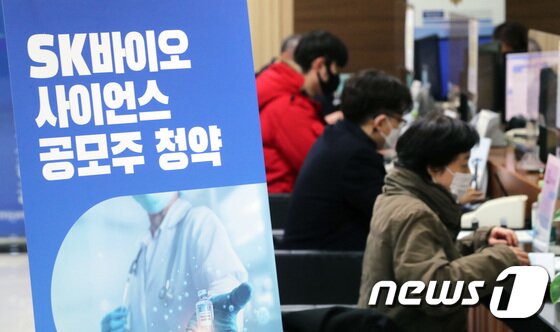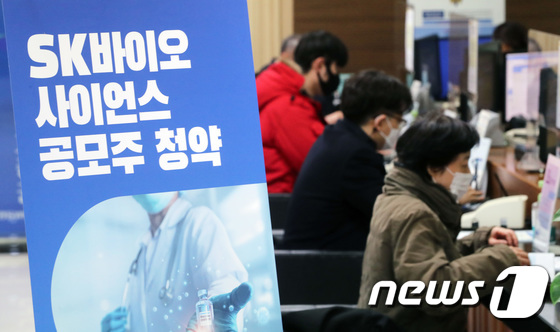 |
| Investors are receiving investment advice at NH Investment & Securities Myeongdong branch in Jung-gu, Seoul on the 9th, when SK Bioscience, one of the earliest words of IPO in the first half of the year, began offering a public offering. SK Bioscience’s offering for two days on the 9th and 10th is 1.5 trillion won, the largest since Netmarble in 2017 (2.661.7 trillion won). SK Biosciences is receiving high attention as it consigns production of the Corona 19 vaccine AstraZeneca (AZ). 2021.3.9/News1 © News1 Reporter Seongcheol Lee |
On the 10th, the last day of the subscription to SK Biosciences, which is considered a major IPO in the first half of this year, investors who want to receive even more allocations for one week are expected to be fierce.
According to the financial investment industry, the average competition rate of SK Bioscience’s public offering stocks as of the first day of offering stocks was 75.87:1. The total amount subscribed to receive 5.37,500 shares of the general public offering amounted to a total of 435.03 million shares. The total number of subscriptions was 1.61,114, which was the highest ever, and the subscription margin was 14,144.7 billion, ranking second after the record-high Kakao Games (16.41 trillion won).
However, when looking at the subscription competition rate by securities company, there is a difference of more than five times from the lowest 30:1 to the highest 154:1. This means that the number of publicly offered stocks to be allocated may vary depending on which securities company you choose.
The securities company with the highest competition rate is Samsung Securities, with a record of 154:1. The amount allocated to Samsung Securities is 28,6875 shares (14,3438 shares of equally allocated amount), and the total number of subscriptions is 42,220,520, and the number of subscriptions is 22,57. Based on Samsung Securities’ competition rate and the number of subscriptions, the equal distribution amount that an investor who subscribes for 10 or more shares, the minimum number of subscription shares, is 0.65 shares. It means that if you are lucky through the lottery, you will be allocated one week, but there is a high possibility that you will receive less than one week. If you add up the number of subscriptions on this day, the last day, the probability of not receiving even one week will be higher.
On the other hand, SK Securities, a securities company with the lowest subscription competition rate, can receive 5.14 shares as of the first day for investors who have subscribed for more than 10 shares, which is the minimum number of shares. This is because the number of subscriptions through SK Securities is 44,586 and the competition rate is 30.9 to 1, and the amount of equal distribution is 22,9500 shares. NH Investment & Securities, which received the largest amount of allocation, received the largest number of 340,000 subscriptions, but the equal allocation amount reached 106,1438 shares, allowing about 3 weeks to be allocated as of the first day.
Even if the same amount is subscribed, the difference in the allocation amount by securities company is because the allocation amount, competition rate, and number of subscriptions by securities company are different. Of course, the final amount of equal distribution between SK Securities and NH Investment & Securities is determined by the number of subscriptions on the last day.
The uniform allocation method introduced from this year refers to distributing 50% of the amount allocated to general investors equally to subscribers who paid a certain amount of margin. This system was introduced to broaden opportunities for small-invested investors to allocate public offerings. The remaining 50% of the quantity is allocated in proportion to the margin.
Investors who want to receive public offering stocks in a proportional method rather than an equal method also need to look at the competition rate on the last day of subscription. If an average competition rate of 75.87 on the first day of subscription is applied, the subscription amount required to receive one share is 2.46 million won, but if the lowest competition rate of 30.9 to 1 is substituted, one can receive one share for 1 million won. Conversely, if 154.3 to 1, the highest competition rate, is applied, 1 week is allocated to 5,100,000 won. If an investor put in 100 million won, it is calculated that up to 80 more shares can be received depending on the subscribed securities company.
The final competition rate can change significantly, considering the fact that more funds are usually concentrated on the second day of the subscription. In the case of Big Hit, which was listed last year, nearly 50 trillion won of subscription margin was gathered on the second day of the subscription.
As a result of SK Bioscience’s demand forecast for institutional investors on the 5th and 6th to determine the public offering price, the competition rate was 1275.47 to 1, a record high in the KOSPI. The public offering price was confirmed at 65,000 won, the top of the Hope Band (49,000 won-65,000 won). The size of the public offering is 1.491.7 billion won. This is the largest since Netmarble in 2017 (2,661.7 billion won).
SK Bioscience’s over-the-counter transaction price is around 200,000 won. In view of this, expectations for so-called’tasang’ (the upper limit price after the initial price is formed from double the offering price) are growing among investors. On the first day of listing, the stock price is 169,000 won.
Since its establishment in July 2018, SK Bioscience, which is consigning the Corona 19 vaccine AstraZeneca (AZ), has been manufacturing biological products such as influenza vaccine and shingles vaccine. Last year, it received approval for a clinical trial plan for the development of a novel coronavirus infectious disease (Corona 19) vaccine, and started to produce a full-fledged vaccine, showing a prominence in the field of infectious disease prevention.
Meanwhile, NH Investment & Securities, Samsung Securities, and Hana Financial Investment are eligible to subscribe to public offering stocks only to investors who have opened accounts up to the day before the subscription commencement date.
